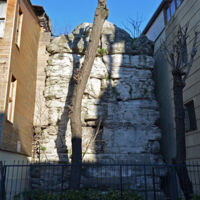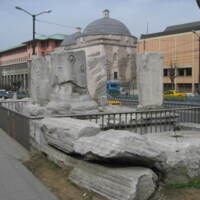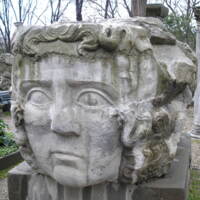WELCOME!
Over the next two weeks Wesleyan University students will take you on a journey through seven wonders of Constantinople, as though you are a visitor to the city in the year 1350.
These Seven Wonders will give you a snapshot of life in this massive medieval city just before the era of the Renaissance, the famous period of cultural production in Italy that was sparked in many ways by immigrants from Constantinople.
First, we will introduce you to the City of Constantinople
Then we will take you through Seven Wonders:
1: Land Walls & the Golden Gate (Defense)
2: Mese and Fora (Imperial Monuments)
3: Embolos (Trade & Commerce)
4: Hippodrome (Sports & Politics)
5: Basilika Cistern (Behind the Scenes)
6: Hagia Sophia (Religious Life)
7: Galata (Diversity of Inhabitants)
Your assignment will be to imagine what it would be like for yourself (or for a historical character you invent) to experience each of these wonders in person, in 1350. You will write a description of each of these experiences, and then conclude the unit by putting them all together. This form of writing is a very medieval thing to do: people from the middle ages wrote about themselves by describing journeys (usually when going on a pilgrimage, like Egeria) or describing the history of their cities (like the Marvels of Rome or the Notes on Constantinople).
This unit will inspire you with a lot of questions about Constantinople. Here are some good web resources to do more exploring:
-
City of Constantine (a google map with some major monuments)
-
Constantinople as Palimpsest (an encyclopedia map created by a Wesleyan University course)
- Byzantine Legacy: Constantinople (informational essays with lots of images on major sites in Constantinople)
-
A detailed historical map with about as many landmarks as we know about:
Recently Added Items
Column of Arcadius Today

The column was demolished in 1719 and the base is now wedged between two buildings with a restaurant tucked behind it. But you can still get a sense…
Remains of the Forum near today's Beyazit Square

The remains of the arch of Theodosius have fallen into disrepair but you can still see the scale the monument once had. Imagine it completed!
Keystone that was probably a part of the forum of Constantine, kept at the Istanbul Archaeological Museum

This is a gorgon head that was a piece of spolia (reused stonework) that may have been part of the forum of Constatntine.
